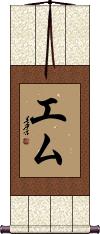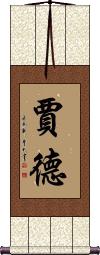Many custom options...
And formats...

Em in Chinese / Japanese...
Buy an Em calligraphy wall scroll here!
Personalize your custom “Em” project by clicking the button next to your favorite “Em” title below...
Jade
Jade
Not the results for Em that you were looking for?
Below are some entries from our dictionary that may match your Em search...
| Characters If shown, 2nd row is Simp. Chinese |
Pronunciation Romanization |
Simple Dictionary Definition |
勿 see styles |
wù wu4 wu motsu まな |
do not (adverb) (archaism) must not; may not Not; do not; translit. <em>mem> and <em>vem>. |
全角 see styles |
zenkaku ぜんかく |
(noun - becomes adjective with の) (See 半角) em; em quad (printing); full-width character |
全身 see styles |
quán shēn quan2 shen1 ch`üan shen chüan shen zenshin ぜんしん |
the whole body; (typography) em (noun - becomes adjective with の) (1) whole (body); full-length (e.g. portrait); (can act as adjective) (2) (See 全身性) systemic whole body |
安廩 安廪 see styles |
ān lǐn an1 lin3 an lin Anrin |
Anlin, a noted monk <em>circaem> A. D. 500. |
月支 see styles |
yuè zhī yue4 zhi1 yüeh chih Gasshi げっし |
the Yuezhi, an ancient people of central Asia during the Han dynasty (also written 月氏[Yue4 zhi1]) Yuezhi; Rouzhi; an ancient Central Asian people (月支國) The Yuezhi, or 'Indo-Scythians', 月氏 (國) and a country they at one time occupied, i. e. 都貨羅 Tukhara, Tokharestan, or Badakshan. Driven out from the northern curve of the Yellow River by the Huns, <em>circaem> 165 B. C., they conquered Bactria 大夏, the Punjab, Kashmir, 'and the greater part of India. ' Their expulsion from the north of Shansi was the cause of the famous journey of Zhangqian of the Han dynasty and the beginning of Chinese expansion to the north-west. Kanishka, king of the Yuezhi towards the end of the first century A. D., became the great protector and propagator of Buddhism. |
イエム see styles |
iemu イエム |
(personal name) Em |
畢利叉 毕利叉 see styles |
bì lì chā bi4 li4 cha1 pi li ch`a pi li cha hirisha |
畢洛叉; 畢剌叉 vṛkṣa is a tree; here it is described as <em>theem> tree i.e. the Jonesia aśoka, a tree under which the Buddha is said to have been born. |
それ行け see styles |
soreike; soreyuke / soreke; soreyuke それいけ; それゆけ |
(interjection) (kana only) go; go go; get to it; up and at 'em |
媒体終端 see styles |
baitaishuutan / baitaishutan ばいたいしゅうたん |
end of medium; EM |
德州撲克 德州扑克 see styles |
dé zhōu pū kè de2 zhou1 pu1 ke4 te chou p`u k`o te chou pu ko |
Texas hold 'em (poker variant) |
全角スペース see styles |
zenkakusupeesu ぜんかくスペース |
{comp} full-width space; em space |
有用微生物群 see styles |
yuuyoubiseibutsugun / yuyobisebutsugun ゆうようびせいぶつぐん |
effective microorganisms; EM |
Variations: |
chiisuto; chesuto / chisuto; chesuto ちぇすと; チェスト |
(interjection) (archaism) (used to cheer sb on) do it; up and at 'em; cheers; hurrah |
テキサスホールデム see styles |
tekisasuhoorudemu テキサスホールデム |
Texas hold 'em (poker game) |
弾幕シューティング see styles |
danmakushuutingu / danmakushutingu だんまくシューティング |
{vidg} bullet hell (genre of shoot 'em ups) |
テキサス・ホールデム see styles |
tekisasu hoorudemu テキサス・ホールデム |
Texas hold 'em (poker game) |
Variations: |
hoorudoapu; hoorudo apu ホールドアップ; ホールド・アップ |
(1) holdup; stickup; (n,vs,vi) (2) holding up one's hands; (interjection) (3) hands up!; stick 'em up! |
Variations: |
tekisasuhoorudemu; tekisasu hoorudemu テキサスホールデム; テキサス・ホールデム |
{cards} Texas hold 'em (poker game) |
鐃循¥申鐃緒申疋鐃緒申奪鐃?鐃循¥申鐃緒申鼻鐃緒申鐃緒申奪鐃? see styles |
鐃循¥申鐃緒申疋鐃緒申奪鐃?鐃循¥申鐃緒申鼻鐃緒申鐃緒申奪鐃? 鐃循¥申鐃緒申疋鐃緒申奪鐃?鐃循¥申鐃緒申鼻鐃緒申鐃緒申奪鐃? |
(1) holdup; stickup; (n,vs,vi) (2) holding up one's hands; (interjection) (3) hands up!; stick 'em up! |
The following table may be helpful for those studying Chinese or Japanese...
| Title | Characters | Romaji (Romanized Japanese) | Various forms of Romanized Chinese | |
| Em | エム | emu | ||
| Em | 艾姆 | ài mǔ / ai4 mu3 / ai mu / aimu | ||
| Jade | ジェイド | jeido | ||
| Jade | 賈德 贾德 | jiǎ dé / jia3 de2 / jia de / jiade | chia te / chiate | |
| In some entries above you will see that characters have different versions above and below a line. In these cases, the characters above the line are Traditional Chinese, while the ones below are Simplified Chinese. | ||||
Successful Chinese Character and Japanese Kanji calligraphy searches within the last few hours...







